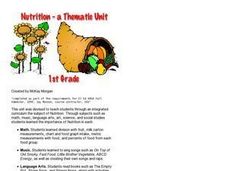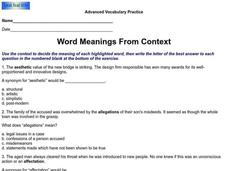Curated OER
Farm Products Help Me Grow
Young scholars view a display of empty food containers (or illustrations). They select a food and decide as a class if it has an animal or plant origin. Students view a display of common farm animals that are commonly eaten (cow, pig,...
EngageNY
End of Unit Assessment Parts 1 and 2: Evaluating Arguments and Claims
Which came first: the chicken or the egg? As part of the end-of-unit assessment for The Omnivore’s Dilemma, scholars watch a video about organic eggs versus conventional farm eggs. They use graphic organizers to collect evidence as they...
Curated OER
Basics About Beef Crossword
In this health learning exercise, students complete an 85 clue crossword puzzle about beef. Questions cover names for various cuts, cooking words, and filler words such as "abbreviation for etcetera."
Curated OER
COLORS ON THE FARM
Students follow directions regarding what colors farm objects should be
colored. They identify various items pictured on provided worksheet that can be found on a farm or are made from farm animals. Finally, they match each color crayon...
Perkins School for the Blind
I'm Thinking Of...
Learning how to describe an object or a person is a great way to develop verbal and written expression. Learners with special needs improve their verbal expressive skills and concept development skills while playing a guessing game. The...
Curated OER
They Don't Just Eat Grass
Students consider the USDA daily recommendations to create a "feed" product for middle schoolers. In this Health instructional activity, students learn about the ingredients in feed that is fed to livestock and apply the method to...
Curated OER
Serfs and Lords
Learners determine what the roles of serfs and lords were in feudal society. In this feudalism lesson, students examine what life was like for the different classes by looking at farm and manor life. They listen to Till Year's Good End,...
Curated OER
Folk and Popular Culture
Good enough for a college class, this resources discusses multiple aspects pertaining to the issues with globalization and the differences between pop and folk culture. It defines major terminology, provides concrete examples, and...
Curated OER
ASL: Lesson 10
Focus on learning how to sign cardinal and ordinal numbers, nouns, and lexicalized fingerspelling. Here is lesson 10 of the series on learning ASL. Provided, are multiple links that provide a visual guide to proper signing. Teach your...
Curated OER
Nutrition: A Thematic Unit
Young learners explore nutrition and the food groups in these two mini-lesson plan ideas. First, kindergarteners have a discussion about their health and how different foods contribute to it before making their own personal food pyramid....
K12 Reader
Simplify with Pronouns
Give your class the task of reducing redundant words by assigning this exercise. Learners use pronouns to replace repeated words in 10 sentences.
Teach-nology
Reading Comprehension: Compare and Contrast
What do a zoo and a farm have in common? Second graders read about each place, and compare and contrast the details using two multiple choice questions.
K12 Reader
Combining Sentences Using Appositives II
Provide young grammarians' additional practice using appositives to combine short sentences with this short worksheet that includes a definition and models.
Curated OER
When is a Noun a Verb? Examining Double Duty Words
Act and act, address and address...there are so many words in our dictionary that can function as nouns or verbs. Start this lesson plan by having your class list as many as they possibly can. When an adequate list presents itself, have...
Curated OER
Comprehension: Inference (Level 1)
Looking for a solid worksheet to help you reinforce the concept of inferences? Here's a good one! Learners read sentences, select the most logical inferences, and tell why those inferences make sense. Eight inferences are identified.
Curated OER
Word Meanings from Context
Here is a vocabulary worksheet in which your scholars determine the meaning of 10 words using context clues from short readings. They choose from among four words and write their answers on the blank lines at the bottom of the page. They...
Curated OER
Comprehension: Identify Story Grammar
This fully scripted lesson could be a big help for someone new to teaching Kindergarten. It outlines what you should do and say as you teach grammar and literary elements such as, main character, setting, and events through reading. The...
Super Duper Publications
WH Question Cards - Pro: Who, What, When, Where, Why
Do you have kids on your caseload with wh questions goals, that need extra practice comprehending and asking who, what, when, where, and why questions? Then this clever app is designed for you!
Have Fun Teaching
Where Am I? (15)
Guess the setting in a series of reading passages that allow learners to make inferences. Five short descriptions prompt kids to match one of four settings, based on context clues.
True Blue Schools
Now, We’re Cooking!
Practice nutritional cooking with a collection of fun meal preparation lessons. Each lesson includes a focus, objective, collaborative activity, and recipe to culminate what young cooks have learned about healthy eating.
Lee & Low Books
First Come the Zebra Teacher’s Guide
Accompany a reading of First Come the Zebra written and illustrated by Lynne Barasch with a teacher's guide equipped with before reading, vocabulary, and after reading activities. Additional social studies,...
Curated OER
Graphing Dairy Production Statistics
Students collect data about dairy production. In this geometry instructional activity, students formulate and model problem solving. They collect data and plot it on a graph.
Curated OER
Living in a Community
Young scholars practice their reading comprehension skills by reading articles about living in a community. They answer questions related to the material to test for comprehension.
Curated OER
They Don't Just Eat Grass
Students explore and examine different types of feed used for livestock. They discuss types of feed, the need for energy and health, and create graphs of food compared to categories. Students organize data and complete worksheets on...

























